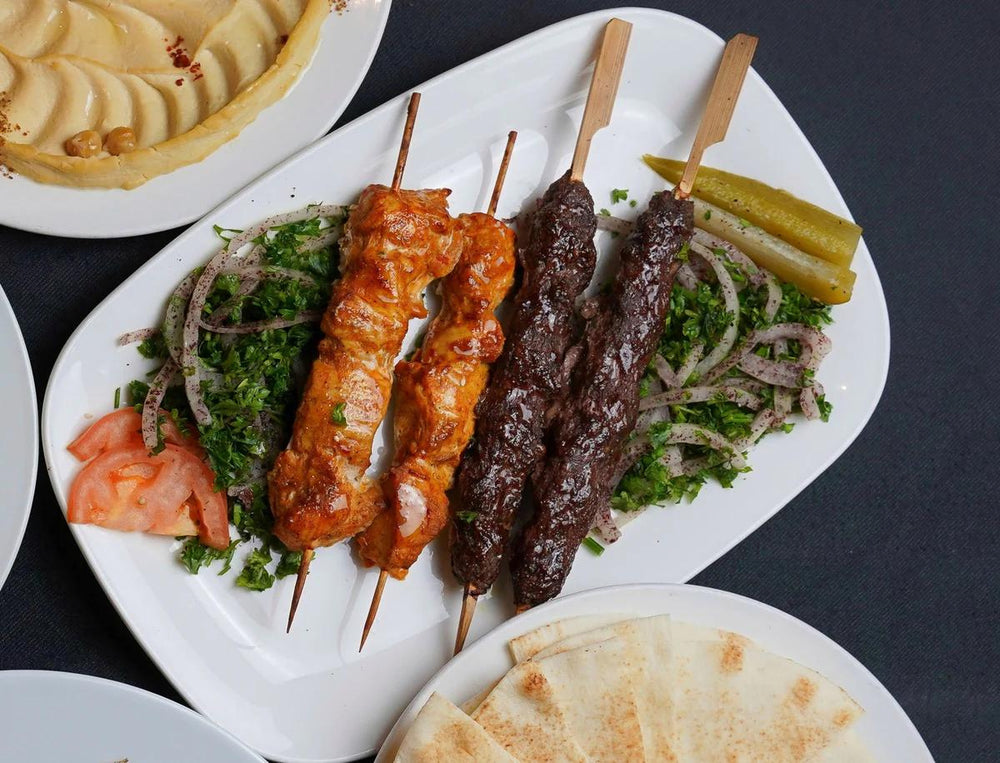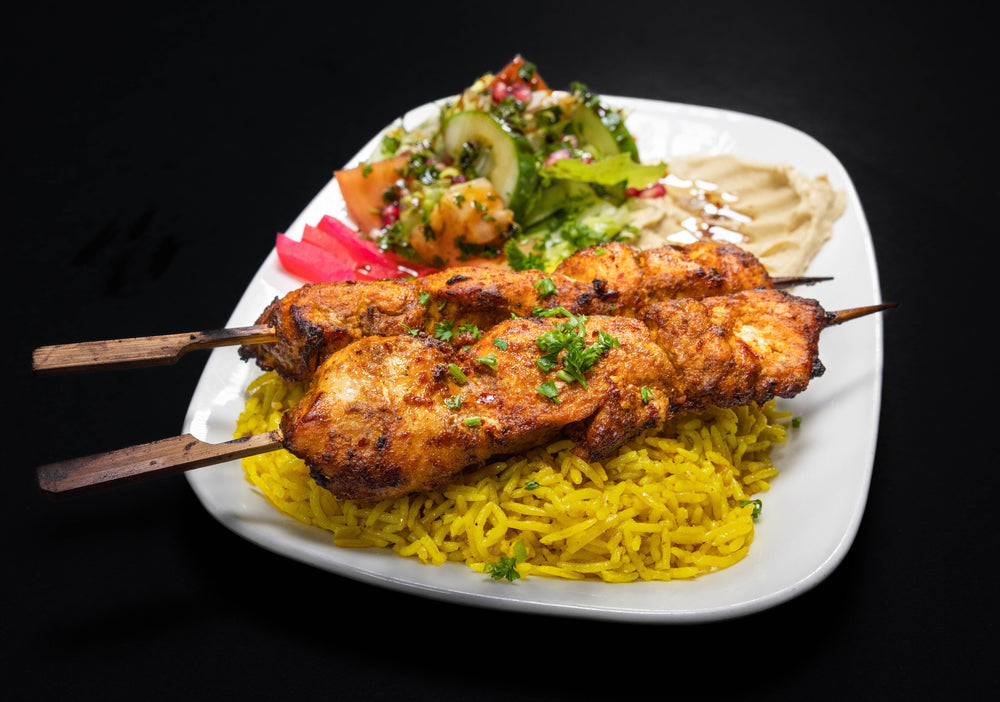Everything about the Rich Flavors and Traditions of Syrian Cuisine: A Culinary Trip
Syrian food uses an one-of-a-kind mix of flavors and traditions that mirror its rich cultural history. With staple ingredients like olive oil and garlic, together with a selection of seasonings, the recipes are both varied and welcoming. From the complex prep work of kibbeh to the wonderful appeal of baklava, each element of this cooking landscape reveals deeper tales. As one checks out the significance of these tastes, a higher understanding of communal eating and party arises.
The Essence of Syrian Ingredients
The essence of Syrian active ingredients depends on their rich variety and ingrained social importance. Influenced by the country's diverse location and history, Syrian food integrates a vast range of flavors, natural herbs, and fresh fruit and vegetables. Staples such as olive oil, garlic, and lemon give a structure, while seasonings like sumac, coriander, and cumin add deepness and intricacy to dishes.The use fresh natural herbs, consisting of parsley and mint, highlights the significance of seasonal active ingredients. Furthermore, the area's productive dirt returns a wealth of vegetables and fruits, such as tomatoes, pomegranates, and eggplants, which are essential to numerous dishes. Grains like bulgur and rice develop the base of several meals, emphasizing the relevance of these active ingredients in Syrian society. This blend of flavors reflects not just a cooking tradition but likewise a tapestry of historic influences, making Syrian components important to comprehending its food's dynamic character.

Iconic Cuisines of Syrian Cuisine
Syrian cuisine is renowned for its famous dishes that display a rich tapestry of appearances and flavors. Conventional meze plates supply a variety of little recipes that tantalize the palate, while hearty major courses give enjoyable focal points for meals (Afternoon Tea Vancouver). To complete the experience, a choice of mouth-watering treats includes a pleasant note to the culinary journey
Traditional Meze Plates

Hearty Main Courses
Hearty main dishes act as the centerpiece of Syrian eating, showcasing a mix of flavors that reflect the country's rich cooking customs. Meals such as kebab hindi, featuring seasoned lamb skewers, and the renowned mujaddara, a calming combination of lentils and rice, highlight using fragrant seasonings and fresh ingredients. An additional staple is the famous kibbeh, made from bulgur wheat and minced meat, usually served in different forms, including baked, fried, or raw. In addition, the flavors of the land come alive in recipes like stuffed veggies, called mahshi, which are filled up with rice, meat, and natural herbs. These main dishes not just satisfy cravings however additionally tell tales of household celebrations and social heritage.
Scrumptious Desserts Selection
A delightful range of desserts specifies the wonderful side of Syrian food, offering a tantalizing end to any kind of dish. Among one of the most popular confections are baklava, delicate layers of phyllo bread filled up with nuts and drenched in syrup, and maamoul, shortbread-like cookies commonly packed with dates or nuts. Knafeh, a rich treat made from thin noodle-like pastry taken in syrup and layered with cheese, is a prominent option, specifically during joyful events. Furthermore, the fragrant and wonderful rice pudding, referred to as roz bil laban, provides a soothing surface. These delicious treats not just display the region's cooking experience yet additionally show the social heritage of Syria, making them cherished deals with in both homes and restaurants alike.
Standard Cooking Strategies
Although modern-day eases have affected lots of cooking techniques, standard cooking techniques stay vital to Syrian cuisine. These methods typically emphasize using fresh, seasonal components and focus on slow food preparation to establish rich tastes. Methods such as cooking, braising, and cooking prevail, permitting the natural tastes of the active ingredients to shine through.One significant method is the preparation of kibbeh, a dish made from finely ground meat and bulgur. It needs competent hand-rolling right into numerous forms and can be baked, fried, or offered raw. Furthermore, the art of making bread, especially pita, is main to many dishes, commonly prepared in a traditional stone oven.Preservation techniques like pickling and fermenting additionally play an important duty, boosting the diversity of tastes found in Syrian recipes. These techniques not just reflect the area's farming heritage however additionally cultivate a strong feeling of community through shared culinary methods.

The Function of Spices in Flavor
Flavors serve as the heart beat of Syrian cuisine, infusing meals with complicated tastes and fragrant deepness. Each spice plays a critical function, contributing not only to taste but additionally to the cultural heritage of the area. Typically used seasonings consist of sumac, coriander, and cumin, each providing a distinct profile that boosts traditional dishes. As an example, cumin gives warmth and earthiness, while sumac adds a zesty illumination, enhancing the overall wikipedia reference dish.Syrian cooks frequently blend flavors to create unified profiles, reflecting the complex balance of flavors that specify the cuisine. The usage of seasonings is not simply for spices; it additionally offers to protect food and boost its dietary value. This thoughtful unification highlights a deep understanding of the cookeries, where seasonings come to be vital authors, conveying the rich background and diverse impacts that define Syrian gastronomy. Eventually, flavors are indispensable in crafting memorable and authentic Syrian meals.
Commemorative Dishes and Joyful Custom-mades
Celebratory dishes in Syrian food are noted by standard feast dishes that mirror the country's rich cooking heritage. Unique celebrations commonly include one-of-a-kind rituals that improve the common experience of eating. These customs not just recognize the value of the occasions however also enhance social and familial bonds.
Standard Feast Dishes
When families gather to celebrate substantial celebrations in Syria, traditional banquet meals take facility phase, showcasing the abundant culinary heritage of the area. These events commonly include dynamic platters of mezze, consisting of hummus, baba ghanoush, and tabbouleh, which offer as delightful starters. The main dish usually highlights lamb or chicken, seasoned and prepared to excellence, typically come with by aromatic rice pilaf or bulgur. One of the most beloved recipes is maqlooba, a layered rice recipe with veggies and meat, flipped upside-down before offering. Sweets likewise play an important role, with baklava and knafeh offering a pleasant surface to the meal. Each meal not only delights the palate however also mirrors the deep-rooted traditions and communal go right here spirit of Syrian society.
Unique Occasion Rituals
Special celebrations in Syria are marked by rich rituals that intertwine food and festivity, showing the cultural relevance of communal gatherings. Celebratory dishes frequently include standard dishes such as kibbeh, tabbouleh, and various smoked meats, prepared with treatment and shared among friends and family. During spiritual vacations like Eid al-Fitr and Eid al-Adha, family members integrated to prepare unique desserts like maamoul, signifying unity and delight. Wedding celebrations are specifically sophisticated, featuring numerous training courses and dynamic displays of friendliness. These events are not simply about food; they incorporate narration, dancing, and songs, reinforcing social bonds and social heritage. With these routines, Syrians celebrate life's turning points, ensuring customs are given via generations, enriching their culinary landscape.
The Value of Sharing and Area
Sharing dishes is a fundamental aspect of Syrian society, mirroring the ingrained worths of area and link. In Syria, food is not just nutrition but a way of bringing individuals with each other. Close friends and family members gather around the table to enjoy conventional recipes, fostering bonds and developing lasting memories. This communal dining experience highlights friendliness, where hosts go to great sizes to guarantee every visitor really feels invited and nourished.The act of sharing food likewise represents kindness and uniformity, strengthening social ties within areas and larger areas. Throughout celebrations, it is common for individuals to serve each various other, showcasing a spirit of togetherness that transcends uniqueness. Parties, whether big or little, are commonly noted by the sharing of dishes, where diverse flavors and recipes collaborated, reflecting the rich tapestry of Syrian society. Appropriately, the relevance of sharing and neighborhood in Syrian cuisine is not only a culinary custom but an important social method.
A Cooking Expedition of Syrian Sugary Foods
Although commonly outweighed by savory dishes, Syrian desserts hold a treasured location in the country's cooking heritage. These confections reflect the area's abundant background, mixing flavors and techniques from different cultures. Typical desserts like baklava, with its layers of phyllo bread, nuts, and honey syrup, display the artistry included in Syrian cooking. Ma'amoul, a shortbread-like cookie full of nuts or days, is typically planned for cheery events, symbolizing hospitality and celebration.Another cherished pleasant is Knafeh, a bread taken in syrup and layered with cheese or cream, offering a wonderful contrast of structures. Syrians additionally delight in a selection of fruit preserves and syrups, often offered with tea or as part of a larger spread throughout celebrations. These desserts not only satisfy the taste buds but also work as a bridge in between generations, maintaining the customs and stories of Syrian society via each delectable bite
Often Asked Inquiries
What Are the Health Benefits of Traditional Syrian Foods?
The health and wellness benefits of standard Syrian foods include abundant nutrients from fresh veggies, legumes, and whole grains. These components advertise heart wellness, boost food digestion, and provide vital vitamins, contributing to total health and a well balanced diet plan.
Exactly How Has Syrian Food Progressed Over the Years?
Syrian food has actually developed substantially, affected by historical trade paths, social exchanges, and local schedule of components. Typical dishes have actually incorporated modern-day tastes and methods while preserving their rich heritage, mirroring a varied cooking landscape.
Exist Vegetarian or Vegan Options in Syrian Food?
Syrian cuisine provides many vegan and vegan alternatives, featuring recipes like falafel, tabbouleh, and packed grape fallen leaves. These dishes highlight the area's abundant agricultural heritage, showcasing fresh vegetables, grains, and fragrant flavors in vivid mixes.
What Beverages Set Well With Syrian Dishes?
When thinking about drinks that enhance Syrian meals, one might discover that mint pomegranate, tea, and ayran juice improve the dish's flavors. Additionally, red a glass of wine usually sets well with the seasonings generally located in these cuisines.
How Can I Recreate Syrian Meals in your home?
To recreate Syrian dishes in your home, one ought to explore authentic dishes, gather conventional active ingredients, and use food preparation techniques one-of-a-kind to the cuisine. Experimenting with flavors and discussion also enhances the overall eating experience. Syrian cuisine is renowned for its renowned dishes that display a rich tapestry of flavors and textures. Spices serve as the heart beat of Syrian food, infusing recipes with complex flavors and fragrant depth. Celebratory dishes in Syrian look at here food are marked by typical feast meals that reflect the country's rich culinary heritage. Events, whether big or little, are usually noted by the sharing of meals, where diverse flavors and dishes come together, mirroring the rich tapestry of Syrian culture. Syrian food uses many vegan and vegan options, including recipes like falafel, tabbouleh, and packed grape leaves.